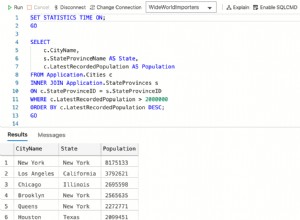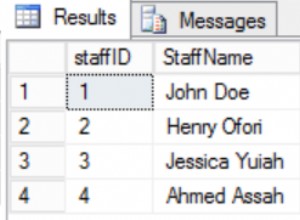Ok, ho scritto classi PHP che estendono le classi di tabelle, righe e set di righe di Zend Framework DB. Lo sto sviluppando comunque perché sto parlando a PHP Tek-X tra un paio di settimane sui modelli di dati gerarchici.
Non voglio pubblicare tutto il mio codice su Stack Overflow perché, se lo faccio, ottengono implicitamente la licenza in Creative Commons. aggiornamento: Ho eseguito il commit del mio codice nell'incubatore degli extra di Zend Framework e la mia presentazione è Modelli per dati gerarchici con SQL e PHP alla condivisione di diapositive.
Descriverò la soluzione in pseudocodice. Sto usando la tassonomia zoologica come dati di test, scaricata da ITIS.gov
. La tabella è longnames :
CREATE TABLE `longnames` (
`tsn` int(11) NOT NULL,
`completename` varchar(164) NOT NULL,
PRIMARY KEY (`tsn`),
KEY `tsn` (`tsn`,`completename`)
)
Ho creato una tabella di chiusura per i percorsi nella gerarchia della tassonomia:
CREATE TABLE `closure` (
`a` int(11) NOT NULL DEFAULT '0', -- ancestor
`d` int(11) NOT NULL DEFAULT '0', -- descendant
`l` tinyint(3) unsigned NOT NULL, -- levels between a and d
PRIMARY KEY (`a`,`d`),
CONSTRAINT `closure_ibfk_1` FOREIGN KEY (`a`) REFERENCES `longnames` (`tsn`),
CONSTRAINT `closure_ibfk_2` FOREIGN KEY (`d`) REFERENCES `longnames` (`tsn`)
)
Data la chiave primaria di un nodo, puoi ottenere tutti i suoi discendenti in questo modo:
SELECT d.*, p.a AS `_parent`
FROM longnames AS a
JOIN closure AS c ON (c.a = a.tsn)
JOIN longnames AS d ON (c.d = d.tsn)
LEFT OUTER JOIN closure AS p ON (p.d = d.tsn AND p.l = 1)
WHERE a.tsn = ? AND c.l <= ?
ORDER BY c.l;
Il join a closure AS p consiste nell'includere l'ID padre di ogni nodo.
La query fa un buon uso degli indici:
+----+-------------+-------+--------+---------------+---------+---------+----------+------+-----------------------------+
| id | select_type | table | type | possible_keys | key | key_len | ref | rows | Extra |
+----+-------------+-------+--------+---------------+---------+---------+----------+------+-----------------------------+
| 1 | SIMPLE | a | const | PRIMARY,tsn | PRIMARY | 4 | const | 1 | Using index; Using filesort |
| 1 | SIMPLE | c | ref | PRIMARY,d | PRIMARY | 4 | const | 5346 | Using where |
| 1 | SIMPLE | d | eq_ref | PRIMARY,tsn | PRIMARY | 4 | itis.c.d | 1 | |
| 1 | SIMPLE | p | ref | d | d | 4 | itis.c.d | 3 | |
+----+-------------+-------+--------+---------------+---------+---------+----------+------+-----------------------------+
E dato che ho 490.032 righe in longnames e 4.299.883 righe in closure , funziona abbastanza bene:
+--------------------+----------+
| Status | Duration |
+--------------------+----------+
| starting | 0.000257 |
| Opening tables | 0.000028 |
| System lock | 0.000009 |
| Table lock | 0.000013 |
| init | 0.000048 |
| optimizing | 0.000032 |
| statistics | 0.000142 |
| preparing | 0.000048 |
| executing | 0.000008 |
| Sorting result | 0.034102 |
| Sending data | 0.001300 |
| end | 0.000018 |
| query end | 0.000005 |
| freeing items | 0.012191 |
| logging slow query | 0.000008 |
| cleaning up | 0.000007 |
+--------------------+----------+
Ora elaboro il risultato della query SQL sopra, ordinando le righe in sottoinsiemi in base alla gerarchia (pseudocodice):
while ($rowData = fetch()) {
$row = new RowObject($rowData);
$nodes[$row["tsn"]] = $row;
if (array_key_exists($row["_parent"], $nodes)) {
$nodes[$row["_parent"]]->addChildRow($row);
} else {
$top = $row;
}
}
return $top;
Definisco anche classi per righe e set di righe. Un set di righe è fondamentalmente una matrice di righe. Una riga contiene un array associativo di dati di riga e contiene anche un set di righe per i suoi figli. Il set di righe figlio per un nodo foglia è vuoto.
Righe e set di righe definiscono anche metodi chiamati toArrayDeep() che scaricano il loro contenuto di dati in modo ricorsivo come un semplice array.
Quindi posso usare l'intero sistema insieme in questo modo:
// Get an instance of the taxonomy table data gateway
$tax = new Taxonomy();
// query tree starting at Rodentia (id 180130), to a depth of 2
$tree = $tax->fetchTree(180130, 2);
// dump out the array
var_export($tree->toArrayDeep());
L'output è il seguente:
array (
'tsn' => '180130',
'completename' => 'Rodentia',
'_parent' => '179925',
'_children' =>
array (
0 =>
array (
'tsn' => '584569',
'completename' => 'Hystricognatha',
'_parent' => '180130',
'_children' =>
array (
0 =>
array (
'tsn' => '552299',
'completename' => 'Hystricognathi',
'_parent' => '584569',
),
),
),
1 =>
array (
'tsn' => '180134',
'completename' => 'Sciuromorpha',
'_parent' => '180130',
'_children' =>
array (
0 =>
array (
'tsn' => '180210',
'completename' => 'Castoridae',
'_parent' => '180134',
),
1 =>
array (
'tsn' => '180135',
'completename' => 'Sciuridae',
'_parent' => '180134',
),
2 =>
array (
'tsn' => '180131',
'completename' => 'Aplodontiidae',
'_parent' => '180134',
),
),
),
2 =>
array (
'tsn' => '573166',
'completename' => 'Anomaluromorpha',
'_parent' => '180130',
'_children' =>
array (
0 =>
array (
'tsn' => '573168',
'completename' => 'Anomaluridae',
'_parent' => '573166',
),
1 =>
array (
'tsn' => '573169',
'completename' => 'Pedetidae',
'_parent' => '573166',
),
),
),
3 =>
array (
'tsn' => '180273',
'completename' => 'Myomorpha',
'_parent' => '180130',
'_children' =>
array (
0 =>
array (
'tsn' => '180399',
'completename' => 'Dipodidae',
'_parent' => '180273',
),
1 =>
array (
'tsn' => '180360',
'completename' => 'Muridae',
'_parent' => '180273',
),
2 =>
array (
'tsn' => '180231',
'completename' => 'Heteromyidae',
'_parent' => '180273',
),
3 =>
array (
'tsn' => '180213',
'completename' => 'Geomyidae',
'_parent' => '180273',
),
4 =>
array (
'tsn' => '584940',
'completename' => 'Myoxidae',
'_parent' => '180273',
),
),
),
4 =>
array (
'tsn' => '573167',
'completename' => 'Sciuravida',
'_parent' => '180130',
'_children' =>
array (
0 =>
array (
'tsn' => '573170',
'completename' => 'Ctenodactylidae',
'_parent' => '573167',
),
),
),
),
)
Riguardo al tuo commento sul calcolo della profondità, o davvero la lunghezza di ogni percorso.
Supponendo che tu abbia appena inserito un nuovo nodo nella tua tabella che contiene i nodi effettivi (longnames nell'esempio sopra), l'id del nuovo nodo viene restituito da LAST_INSERT_ID() in MySQL oppure puoi ottenerlo in qualche modo.
INSERT INTO Closure (a, d, l)
SELECT a, LAST_INSERT_ID(), l+1 FROM Closure
WHERE d = 5 -- the intended parent of your new node
UNION ALL SELECT LAST_INSERT_ID(), LAST_INSERT_ID(), 0;




